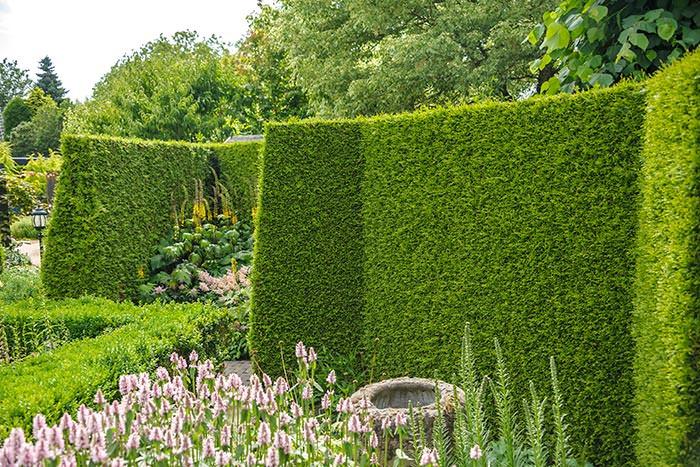How Long Does It Take To Receive An Order From Thuja Gardens

Thuja Care
Thuja is a coniferous plant popular for hedging as it stays dense and bushy and can create a great habitat for birds. There are many varieties of Thuja, but the most popular cultivars belong to the Thuja Plicata (Western Red Cedar) and Thuja Occidentalis (Northern White Cedar) groups. Even with the diversity of Thuja varieties, the principles of Thuja care are the same for all. This makes it much easier to properly nurture Thuja cultivars.

Thuja varieties are low-maintenance and offer interest without asking much in return. The ease of Thuja care is one of the reasons why it is the main alternative to Cupressus Leylandii or Leyland Cypress. Both conifers are ideal for evergreen screening and hedging purposes, but as Thuja is not as fast growing (in comparison to Leylandii) it does not need as much attention. Leyland Cypress requires pruning at least twice a year, as it has a very vigorous growth rate.
How to Properly Plant Thuja
Once you transplant a Thuja to the garden, proper watering should be your primary concern. Getting the water down to the root system of every one of these plants is essential, as they will dry out otherwise. The amount of water a plant will need depends on its age and size. We sell these trees as mature plants with fairly large root balls, so you should be watering every other day for at least a few minutes on each root ball.
This will ensure your new Thujas do not dry out or get yellowing or browning of the foliage- which is a common symptom of insufficient watering.
Feeding
After your Thuja root balls have been thoroughly soaked, you should also use liquid fertiliser to encourage new growth. We use Miracle-Gro Liquafeed fertiliser on our own plants- ideally the one that attaches to a hose. You can easily find this fertiliser on Amazon or at DIY stores such as Homebase.
When Planting In Winter
The only exception to this rule is if the root ball has been planted in the colder part of the year: no watering if the temperatures are below 10 degrees Celsius. In the UK, this usually means you should not water Thuja from November to March. Wait until Spring before feeding your plants. Ideally, it would be sometime around April, when these coniferous plants start their growing season again.
After Care – Up To Two Years
Within the first two years from planting, Thuja cultivars will not have a fully developed root system that would allow it to support itself. Without a little help in the form of burlap tree ties (a hessian fabric) to keep its branches in place, a young Thuja can be at risk of splitting in harsh weather conditions. However, around 3 years of age, a Thuja cultivar becomes fully established and fully hardy. At Paramount Plants and Gardens, you can get both young Thuja plants and more mature specimens.
Thuja Care: Common Problems
Although Thuja plants are fairly easy to grow and to care for, they will need a bit of assistance until they are fully established in the garden. For a minimum of 2 years after planting, you will need to pay special attention to watering, feeding, pruning, and weeding. This will minimise the potential for common Thuja plant issues to occur.
The most frequent issue gardeners have with Thuja is browning. If the foliage of your new plant turns from green (or golden, like in the case of Thuja Occidentalis Golden Globe or Thuja occidentalis Fire Chief White Cedar Congabe) to a dull brown, it is a sign that something is wrong with the plant. Usually, the underlying issue is that the root system is not getting enough water.
To remedy the issue, increase watering and prune away any brown or yellowing foliage. Unlike Cupressus Leylandii, Thuja will regrow if the dead foliage is cut back. In fact, Thuja will naturally have some browning regardless of the conditions, but pruning and feeding will assist in producing new foliage each year.
To prevent Thuja drying in the winter, when it should not be watered, rely on mulch to protect the roots and keep moisture at an optimal level. A combination of composted bark chippings mixed with compost is our prefered choice.
Summary
Thuja plants are low-maintenance and do not need much care to thrive. To prevent common Thuja problems such as browning, make sure to water properly and feed with a liquid fertiliser. As a rule of thumb, most Thuja cultivars under 3 years of age will do well if watered every other day. The key is to provide enough moisture to the root system. In winter, this can be achieved by placing a layer of mulch mixture to protect the roots from drying out. In case your Thuja already has browning foliage, simply cut back the dead growth- and the foliage will regenerate in the spring.
Related Posts
How Long Does It Take To Receive An Order From Thuja Gardens
Source: https://www.paramountplants.co.uk/blog/index.php/thuja-care/
Posted by: clarkeblamot.blogspot.com

0 Response to "How Long Does It Take To Receive An Order From Thuja Gardens"
Post a Comment